...It's never
really finished.
When I made my first set of homebrew Atari volcano buttons, I knew I was going to want to re-do them someday. Sculpey proved far easier to sand than I expected, and that accidentally resulted in a variety of sizes among the cones. I had also tried a mix of "metal" and black cones, and it just didn't work for me. So I ordered a couple of volcano cherry switches off of Ebay for five bucks, then set about casting a set of 12 from one of those cones.
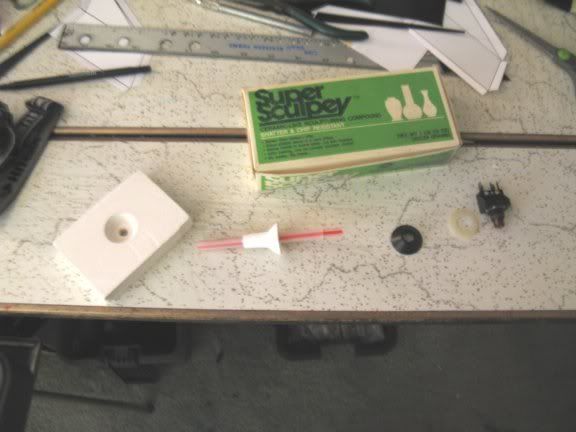
Left - the plaster cast; Middle Top - wonderful Sculpey; Middle Bottom - a funnel tip and thick plastic straw that was my original mold; Right - cherry switch, washer and cone.
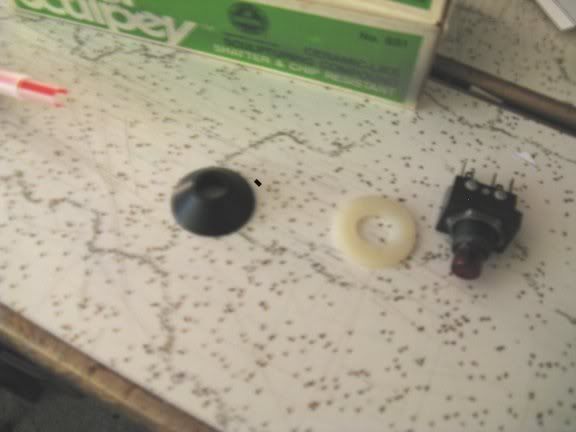
I only used the cone from the cherry switch assembly. I already had an array of 12 switches installed, and it would have been a royal pain (and expensive) to replace them all with cherry switches. I actually got a pair off Ebay; one was perfect, the other was scarred with the familiar cigarette burn and so useless to me...
I filled the cone's center with Sculpey before casting-- otherwise it would have gotten stuck in the mold (it's threaded inside). Then I poked the straw through that center filling. The straw is the same size as the buttons in my panel, so having the straw in the center during casting made a proper sized hole in the top of the mold. I applied a light smear coating of Vaseline on the cone to keep it from bonding to the plaster, then poured the mold.

(underside of the mold)
After the mold hardened, then I pressed 12 wads of Sculpey into it, one at a time (making sure to smear the mold with a small dab of vaseline before each). Then I stuck the straw in from the top to punch out the hole, and also to help push the cone from the mold without distorting the shape. Then I dropped the cones in a glass dish and baked them (about 25 minutes for something this size). After they cooled, I lightly sanded any rough edges, then applied a few coats of black rustoleum.

Voilŕ! 12 cones, uniform shape and color. I had all this stuff lying around, so it only cost me ten bucks total and that was just for ordering the original cone off Ebay.
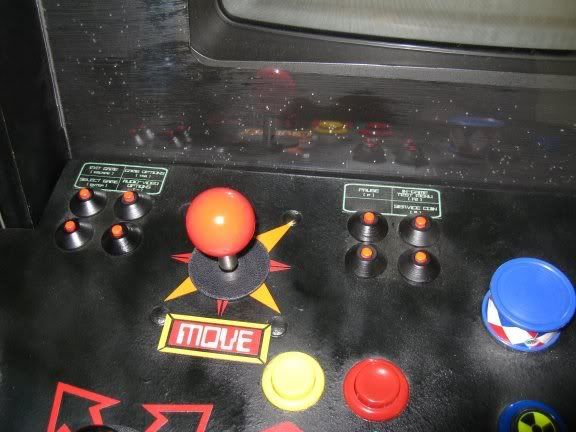
I was content with non-illuminated buttons, again considering the cost of accumulating 12 cherry switches and the prospect of some awkward router work. Then a light went on in my head: I had already installed a blacklight to kick on the glow in my Tron and Satan's Hollow sticks. So I got some red flourescent paint, painted all the red buttons, and once that dried I applied a generous amount of clear gloss coat; several layers, in fact, to last through many, many presses. I also got a sheet of flourescent yellow paper, and printed out the radioactive symbol as an insert for the center button on the top tier.
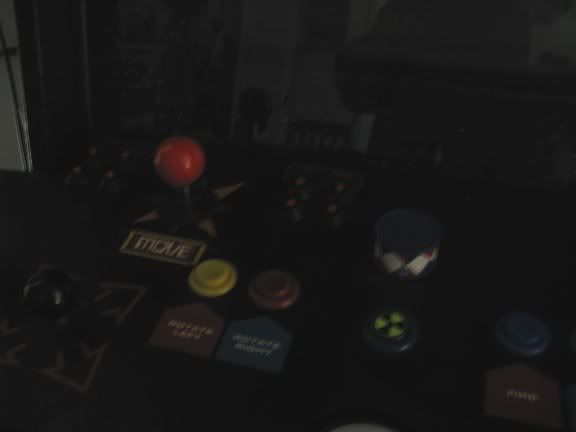
...Machine off...
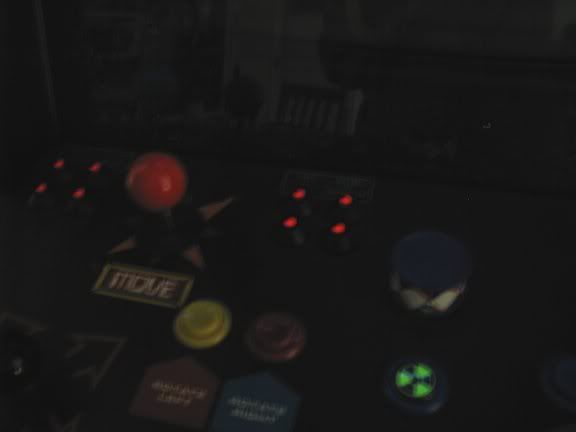
...Machine ON!
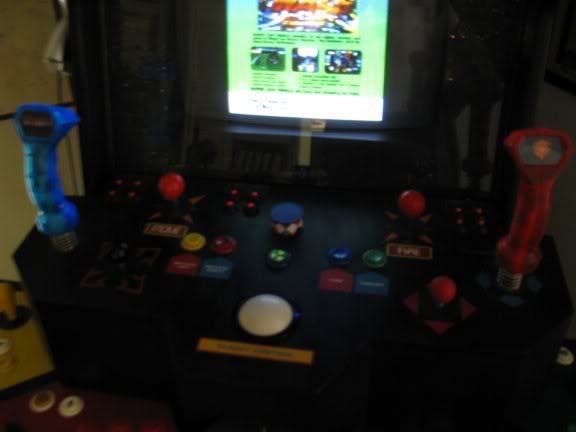
I'm much happier with the cone array now. The uniform shapes look so much better, but either way I should have gone with a single color for the entire array from the very start.
Moving on to the new Aimtrak! Below is the Aimtrak gun in its holster. I made the holster out of the black plastic cover from one of those narrow 3-ring binders-- the plastic is a single textured sheet, thin but sturdy.
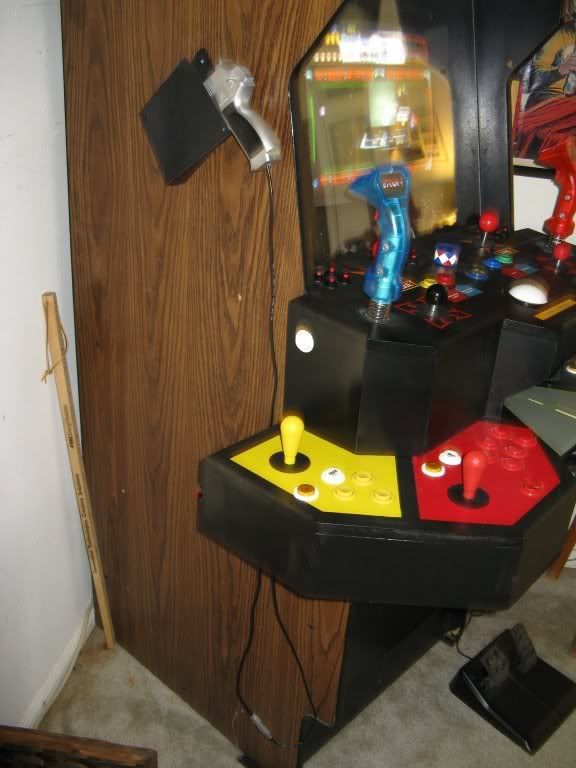
The gun is an old PS1 Guncon, gutted and repainted.

The following is a tale of espionage and intrigue.
It begins with installing the LED bar for the Aimtrak. I mounted the bar through the back of the cardboard bezel, then dropped the USB cable down into the cabinet. Per Andy's recommendations, the LED bar needed to be connected directly to a USB slot on the MB, and not through a hub.
Now, back when I put the PC in the cabinet, I didn't bother disassembling the PC; I just removed the case cover and bolted the open case to the inside of the cab, then ran a couple of USB cables to hubs accessible via the coin door. This lazy, boneheaded decision now put me in the position of having to bend my wrist, arm, and a certain portion of my torso into a most awkward and somewhat painful shape, all in order to reach that one remaining USB slot on the back of the PC case. It was one of those reaches that strips humans of their most powerful appendage, the opposable thumb; only the first and second fingers could clumsily pinch the plug in that remote, unseeable cranny, and the plug itself seemed mischievously determined to escape those fingers at every turn.
...And I could do another paragraph on how after all that, the plug would be flipped the wrong way, but I'll spare you.
It took me twenty frickin' minutes to get that frickin' plug in there. Roughly the same amount of time it would have taken to yank the PC case out, but whatever.
But now I've got it plugged in, and I'm ready to test out the Aimtrak! I hit the power switch--
*POP* *hissssssssss* (acidic smell)
HolyCRAPyankthepowerplugOUToftheWALL—
…Fried power supply. So now I have to pull out the PC case anyway.
Fortunately, I had an extra power supply in a junked PC; I was just hoping that nothing else got fried. It also gave me a reason to finally pull out that PC case and strip it down to just the MB, HD, PS and fans. It also gave me a reason to look into another nagging problem…
The PC was a hand-me-down, and ever since I’ve had it there has been a small but perpetual annoyance. The AOpen MB has a “Doctor Voice” feature that tells you why your PC isn’t starting; it says stuff like “your keyboard may have a problem” if the keyboard isn’t connected, for example. On this PC, every now and then when I would press the power button it would refuse to boot, and I would hear a small voice repeating “your CPU may have a problem. Your CPU may have a problem”. I’d unplug it and turn it on again, and after repeating this process a couple of times it would boot and work fine. No crashes, no problems at all, in fact, until I’d turn it on again next time.
So now that I’ve got the MB out, I decide I’m going to look into this problem. I might as well, since at this point I’m figuring I’m probably going to have to replace it anyway, so no harm in monkeying with it. Previous searches on this message told me that it had something to do with CPU temperature, most likely a heat-damaged CPU. But I always got this message when the CPU was
cold…(!)
Googling this message along with the MB specs, I kept coming across a strange tale. Back around 2003(?) a Chinese (Japanese?) electrical engineer stole a formula for an electrolytic solution from his employer, then ran off and sold it to a Taiwanese manufacturer, who in turn used the stolen formula to produce thousands of capacitors. Problem was, the formula he gave them was bad; copied incorrectly or something down the line. Electronics all over the place started failing, tainted by these capacitors bursting like teenage acne.
So I yank and toss the bad power supply, and now I can get a good look at the motherboard for the first time. And sure enough, right next to the CPU are two capacitors that look like ripe grapes. Fluid is gooping out the tops of both. Again, I’m thinking the MB is probably headed for the scrap heap, so no reason not to at least try to fix it—a couple of capacitors is a lot less than a new MB .
A few months back, my father, a former electrical engineer, came over to help me re-cap my monitor (in other words, after forty years I finally let my Dad teach me how to solder). I took this lesson to my motherboard, and quickly realized that my Dad is a soldering frickin’ samurai. In more time than it took his dancing hands to recap a whole monitor board, I smothered those two capacitors with enough expletives to make the crew of an aircraft carrier blush. But I finally got them in there, seated nice and low on the board and with no stray solder. As I mounted the board in the cab, I was still ruminating on where I was going to get a good motherboard with an AGP slot so I wouldn’t have to buy another ArcadeVGA…
No one was more surprised than I when it actually booted up. Well, no one really cared, but I did try to describe to my wife the event like unto a cosmic convergence that had just occurred, and she just gave me that smile that says “I don’t really get it, but good for you, Honey”. Then she said, “Good for you, Honey!”
…It’s been a couple of months now, and I haven’t heard “your CPU may have a problem” since.
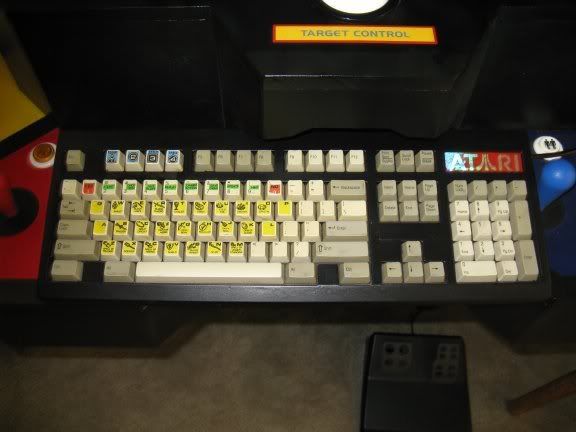
Some gussying-up of the Thayer’s Quest-labeled keyboard. I layered several coats of clear gloss onto the keys, basically turning the paper stickers into plastic. I shaved the edges of the stickers with an exacto knife to make them nice and smooth and flush with the keys, and now you can rake your fingers across the keys without noticing the stickers at all. I had a few of these metallic Atari stickers that I have no idea from whence they came, and one of them fit quite nicely into an indentation in the upper right.
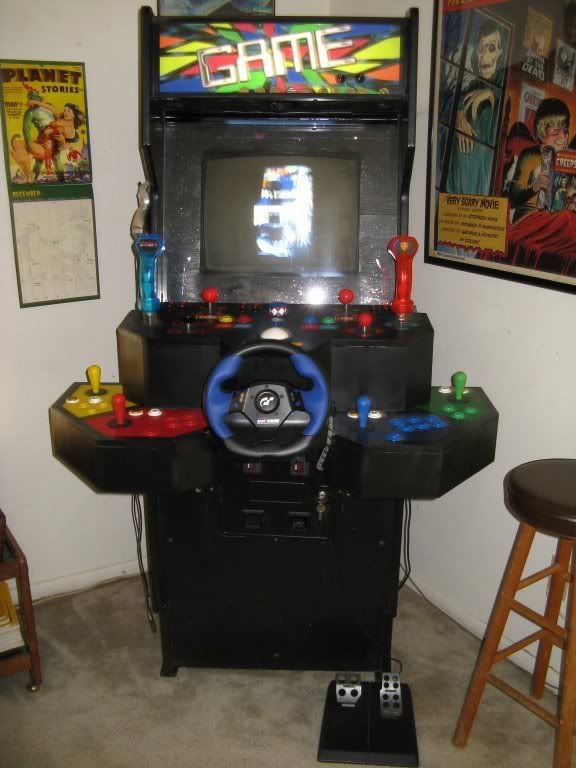
Steering wheel in place ‘cause my 5 year old nephew likes
Spy Hunter.
Lastly, ever since this thing came to life around last Christmas, I have been slowly playing through
every game in the “Available” list (v112 MAME32; about 2800 games filtering out non-working, clones, mahjong, etc.). This is mainly to check controls for all the games on the machine, choose the best looking resolution for each, and turn my Favorites list into a roster of all games that can be comfortably played on this machine.
Fortunately, using the default wiring configuration on the I-Pac results in the majority of games already being set up perfectly; I usually only have to tweak games with analog controls, for example. I like to rearrange the player order on 4-player games so that the onscreen player colors match the colors on the 4 player panel, if I can, and I also like to set up controls for single player games so they can be played either right or left handed; stuff like that. (Anybody come up with an easily accessible, competent substitute for those little metal spring-flicky joysticks used on late 80’s sports games like
Quarterback?)
Most of the time, though, I just start up a game, give it a quick play, add it to the Favorites list and move on to the next. I sorted the list by year, then started with the newest game on the list, and ever since have been slowly going back in time; I figured working backwards toward the games of my childhood would keep me interested. The newest game was 2005 (IIRC), and now, a year later, I have traveled back to the year 1987—a little more than halfway through the list.
I’ve found a lot of cool games this way, ones I’d never heard of that stopped my time-traveling in its tracks and kept me occupied for a good while. There were also some rough patches—the mid-90’s Street-Fighter clone era was particularly arduous, and I’m still not free of the Japanese vertically scrolling shooters that require you to rapidly press the fire button through every nanosecond of play. But it’s a fun ride, I’m not done yet, and the nostalgia just keeps building.
So, Happy New Year all! Hopefully by this time next year, I’ll have made it to 1975.




 Home
Home Help
Help Search
Search Login
Login Register
Register
 Send this topic
Send this topic Print
Print



